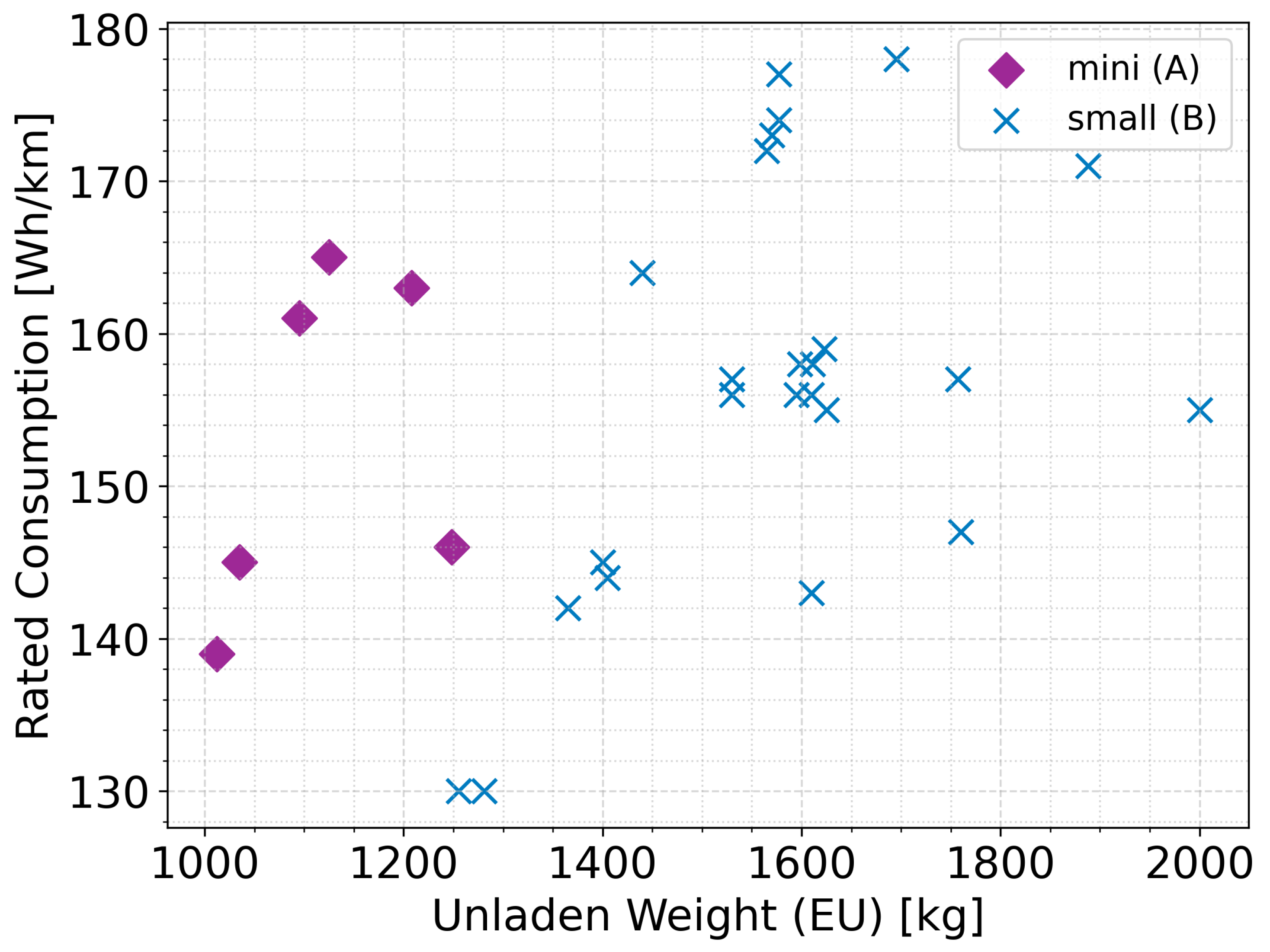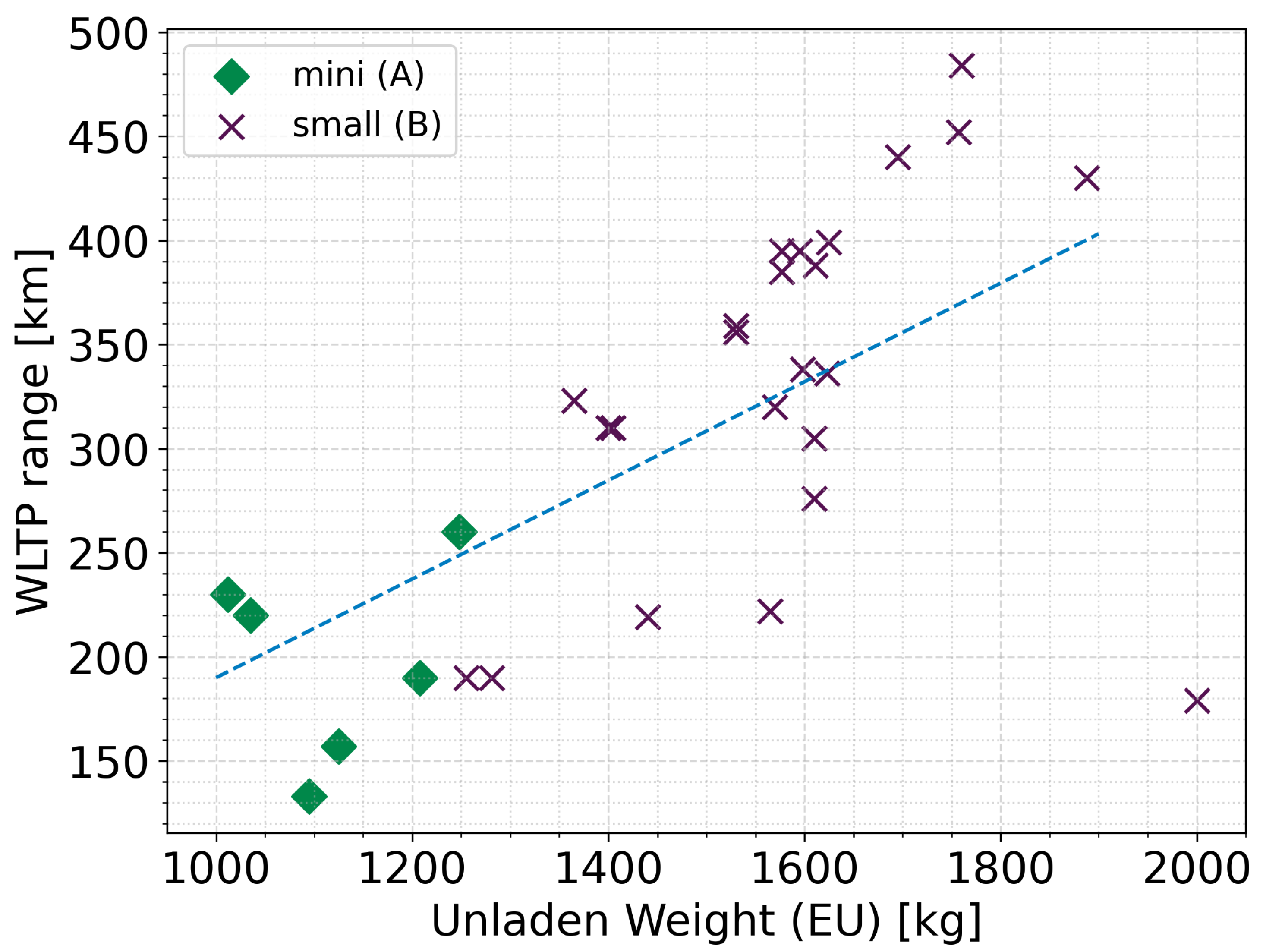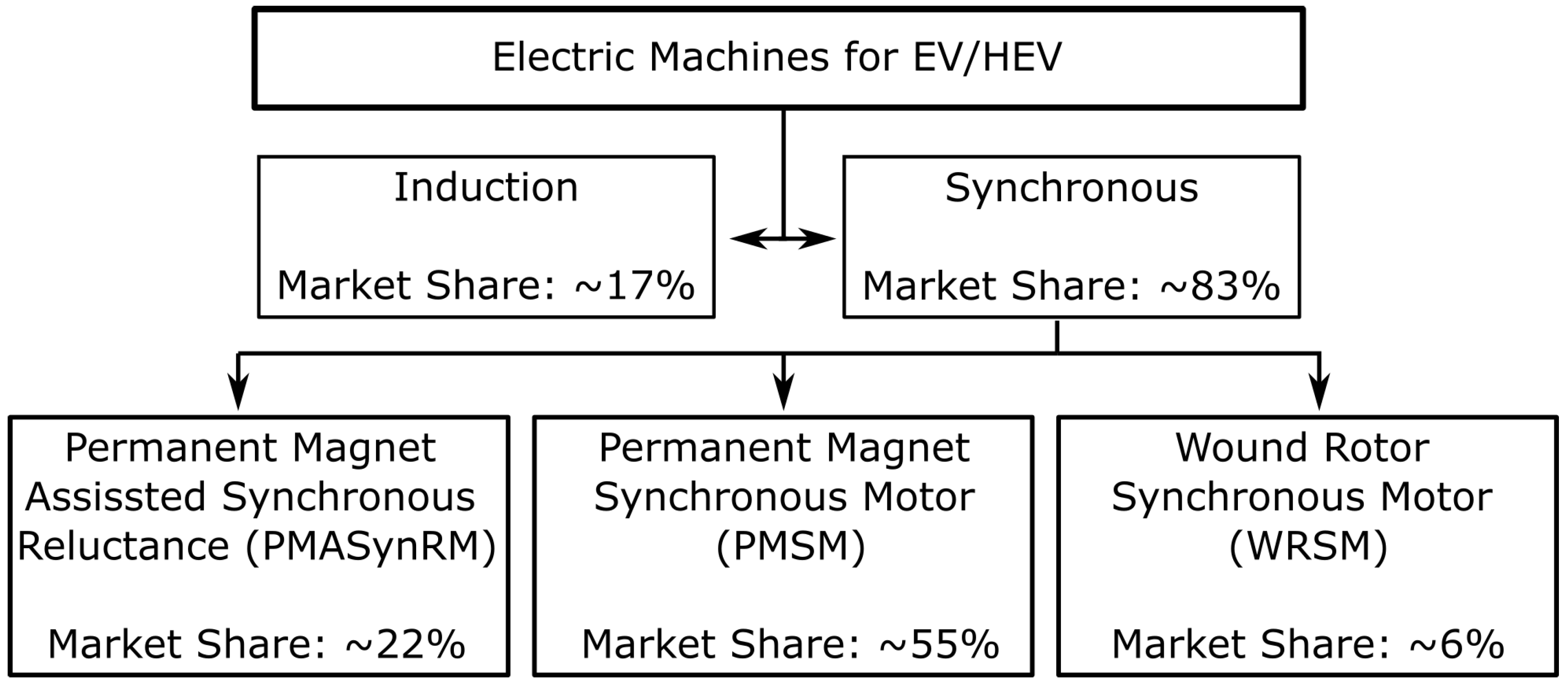Circular Economy Aspects of Permanent Magnet Synchronous Reluctance Machine Design for Electric Vehicle Applications: A Review
Abstract
1. Introduction
2. The Ecological Impact of Drivetrain Components Considering the Circular Economy Model
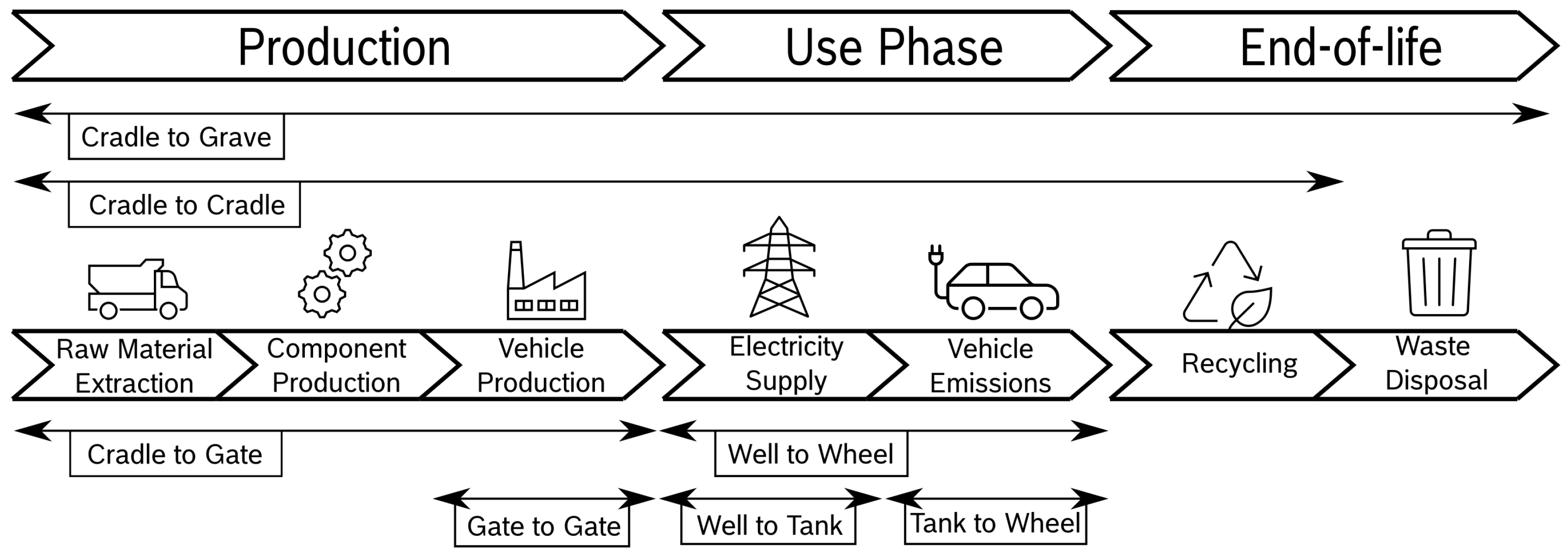
The 4R Strategies in the Case of Electrical Drivetrain Main Components
3. Suitable Materials and Electric Machine Types for Circular Economy
3.1. Permanent Magnets Used in Electric Vehicles’ Traction Motors
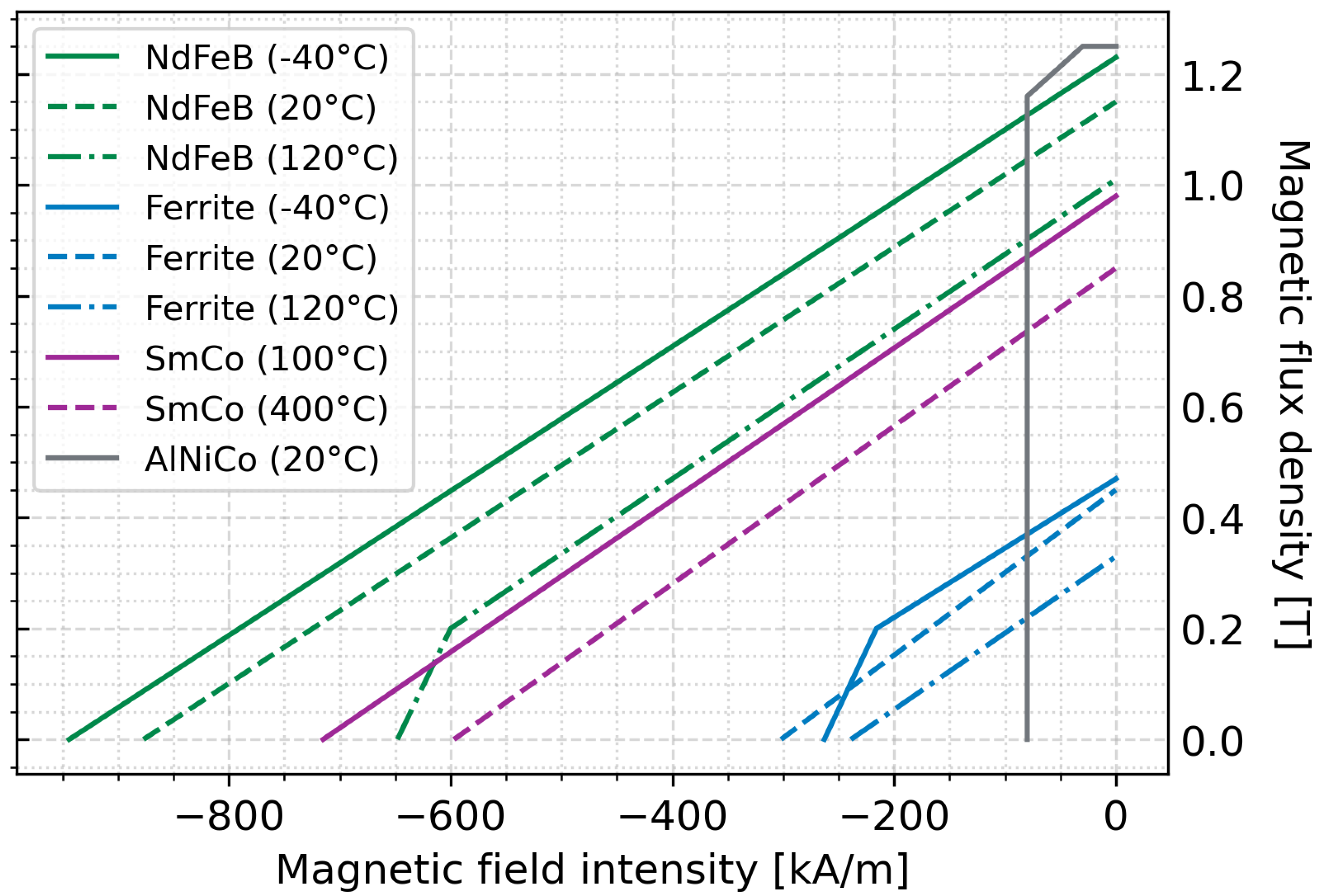
3.2. Comparison of Different Machine Types with Rare-Earth Element and Non-Rare-Earth Element Magnets
3.3. Ecological Aspects of Aluminium and Copper Windings
4. Technical Summary of the Suitable Electric Vehicle Category
4.1. Characteristics of Mini (A) and Small (B) Segment Electric Vehicles
4.2. Characteristics of Different Urban Drive Cycles
5. Electric Machine Design with Circular Economy Aspects in Electric Vehicles
6. Summary
Author Contributions
Funding
Data Availability Statement
Conflicts of Interest
Abbreviations
| BEV | Battery Electric Vehicle |
| EV | Electric Vehicle |
| OEM | Original Equipment Manufacturer |
| PMSM | Permanent Magnet Synchronous Machine |
| NdFeB | Neodymium–Iron–Boron |
| PMASynRM | Permanent Magnet-Assisted Synchronous Reluctance Machine |
| SynRM | Synchronous Reluctance Machine |
| ICEV | Internal Combustion Engine Vehicle |
| EoL | End-of-Life |
| CE | Circular Economy |
| EU | European Union |
| 4R | Reuse, Refurbishment, Remanufacturing, or Recycling |
| REE | Rare-earth element |
| SmCo | Samarium–Cobalt |
| AlNiCo | Aluminium–Nickel–Cobalt |
| SmFeN | Samarium–Iron–Nitride |
| CRM | Critical Raw Material |
| EREAN | European Rare-Earth Magnet Recycling Network |
| SUSMAGPRO | Sustainable Recovery, Reprocessing and Reuse of Rare-Earth Magnets |
| in a Circular Economy | |
| DEMETER | Design and Recycling of Rare-Earth Permanent Magnet Motors and |
| Generators in Hybrid and Full Electric Vehicles | |
| PMVM | Permanent Magnet Vernier Motor |
| STPMSM | Spoke-Type Permanent Magnet Synchronous Machine |
| UW | Unladen Weight EU |
| FI-PMASynRM | Flux-Intensifying Permanent Magnet-Assisted Synchronous |
| Reluctance Machines | |
| NBC | Nominal Battery Capacity |
References
- European Environment Agency. Electric Vehicles from Life Cycle and Circular Economy Perspectives: TERM 2018: Transport and Environment Reporting Mechanism (TERM) Report; European Environment Agency: Koppenhagen, Denmark, 2018. [Google Scholar] [CrossRef]
- Deloitte. Global Automotive Consumer Study. 2023. Available online: https://www2.deloitte.com/us/en/pages/consumer-business/articles/global-automotive-consumer-study.html (accessed on 13 March 2024).
- Giffi, C.A.; Vitale, J., Jr.; Schiller, T.; Robinson, R. A reality check on advanced vehicle technologies. In Insights Exploring New Automotive Business Models and Consumer Preferences; Deloitte: London, UK, 2018; Available online: https://www2.deloitte.com/us/en/insights/industry/automotive/advanced-vehicle-technologies-autonomous-electric-vehicles.html (accessed on 12 March 2024).
- Kawecki, N. The global automotive consumer study—Case study. Sci. Pap. Silesian Univ. Technol. Organ. Manag. Ser. 2022, 2022, 281–292. [Google Scholar] [CrossRef]
- Hernandez, M.; Messagie, M.; Hegazy, O.; Marengo, L.; Winter, O.; Van Mierlo, J. Environmental impact of traction electric motors for electric vehicles applications. Int. J. Life Cycle Assess. 2017, 22, 54–65. [Google Scholar] [CrossRef]
- Raghuraman, B.; Nategh, S.; Sidiropoulos, N.; Petersson, L.; Boglietti, A. Sustainability Aspects of Electrical Machines For E-Mobility Applications Part I: A Design with Reduced Rare-earth Elements. In Proceedings of the IECON 2021—47th Annual Conference of the IEEE Industrial Electronics Society, Toronto, ON, Canada, 13–16 October 2021; pp. 1–6. [Google Scholar] [CrossRef]
- Alibeik, M.; dos Santos, E.C. High-Torque Electric Machines: State of the Art and Comparison. Machines 2022, 10, 636. [Google Scholar] [CrossRef]
- Commission, E.; Centre, J.R.; Buchert, M.; Schüler, D.; Pavel, C.; Tzimas, E.; Alves Dias, P.; Marmier, A.; Jenseit, W.; Blagoeva, D.; et al. Substitution of Critical Raw Materials in Low-Carbon Technologies: Lighting, Wind Turbines and Electric Vehicles; Publications Office of the European Union: Luxembourg, 2016. [Google Scholar]
- Jin, H.; Afiuny, P.; Dove, S.; Furlan, G.; Zakotnik, M.; Yih, Y.; Sutherland, J. Life Cycle Assessment of Neodymium-Iron-Boron Magnet-to-Magnet Recycling for Electric Vehicle Motors. Environ. Sci. Technol. 2018, 52, 10. [Google Scholar] [CrossRef] [PubMed]
- Horváth, C. The Current Situation of the Rare-Earth Material Usage in the Field of Electromobility. In Proceedings of the Vehicle and Automotive Engineering 4; Jármai, K., Cservenák, Á., Eds.; Springer: Cham, Switzerland, 2023; pp. 493–504. [Google Scholar] [CrossRef]
- Kalmykova, Y.; Sadagopan, M.; Rosado, L. Circular economy—From review of theories and practices to development of implementation tools. Resour. Conserv. Recycl. 2018, 135, 190–201. [Google Scholar] [CrossRef]
- Jeong, C.; Park, J.; Bianchi, N. Alternatives to Replace Rare-Earth Permanent Magnet Motors in Direct Drive Applications. In Proceedings of the 2020 International Symposium on Power Electronics, Electrical Drives, Automation and Motion (SPEEDAM), Sorrento, Italy, 24–26 June 2020; pp. 276–281. [Google Scholar] [CrossRef]
- Giménez-Nadal, J.I.; Molina, J.A.; Velilla, J. Trends in commuting time of European workers: A cross-country analysis. Transp. Policy 2022, 116, 327–342. [Google Scholar] [CrossRef]
- Bergantino, A.S.; Madio, L. Intra- and inter-regional commuting: Assessing the role of wage differentials. Pap. Reg. Sci. 2019, 98, 1085–1114. [Google Scholar] [CrossRef]
- Echeverría, L.; Giménez-Nadal, J.I.; Alberto Molina, J. Who uses green mobility? Exploring profiles in developed countries. Transp. Res. Part A Policy Pract. 2022, 163, 247–265. [Google Scholar] [CrossRef]
- Davis, S.C.; Boundy, R.G. Transportation Energy Data Book: Edition 40. 2022. Available online: https://tedb.ornl.gov/wp-content/uploads/2022/03/TEDB_Ed_40.pdf (accessed on 13 March 2024).
- Li, K.; Wang, L. Optimal electric vehicle subsidy and pricing decisions with consideration of EV anxiety and EV preference in green and non-green consumers. Transp. Res. Part E Logist. Transp. Rev. 2023, 170, 103010. [Google Scholar] [CrossRef]
- Orosz, T.; Rassõlkin, A.; Kallaste, A.; Arsénio, P.; Pánek, D.; Kaska, J.; Karban, P. Robust Design Optimization and Emerging Technologies for Electrical Machines: Challenges and Open Problems. Appl. Sci. 2020, 10, 6653. [Google Scholar] [CrossRef]
- Sachs, G. Electric Vehicles Are Forecast to be Half of Global Car Sales by 2035. 2023. Available online: https://www.goldmansachs.com/intelligence/pages/electric-vehicles-are-forecast-to-be-half-of-global-car-sales-by-2035.html (accessed on 13 March 2024).
- Li, Y.; Lei, G.; Bramerdorfer, G.; Peng, S.; Sun, X.; Zhu, J. Machine learning for design optimization of electromagnetic devices: Recent developments and future directions. Appl. Sci. 2021, 11, 1627. [Google Scholar] [CrossRef]
- Diao, K.; Sun, X.; Bramerdorfer, G.; Cai, Y.; Lei, G.; Chen, L. Design optimization of switched reluctance machines for performance and reliability enhancements: A review. Renew. Sustain. Energy Rev. 2022, 168, 112785. [Google Scholar] [CrossRef]
- Silvas, E.; Hofman, T.; Murgovski, N.; Etman, L.F.P.; Steinbuch, M. Review of Optimization Strategies for System-Level Design in Hybrid Electric Vehicles. IEEE Trans. Veh. Technol. 2017, 66, 57–70. [Google Scholar] [CrossRef]
- Mazali, I.I.; Daud, Z.H.C.; Hamid, M.K.A.; Tan, V.; Samin, P.M.; Jubair, A.; Ibrahim, K.A.; Kob, M.S.C.; Xinrui, W.; Talib, M.H.A. Review of the Methods to Optimize Power Flow in Electric Vehicle Powertrains for Efficiency and Driving Performance. Appl. Sci. 2022, 12, 1735. [Google Scholar] [CrossRef]
- Garza-Reyes, J.A.; Kumar, V.; Batista, L.; Cherrafi, A.; Rocha-Lona, L. From linear to circular manufacturing business models. J. Manuf. Technol. Manag. 2019, 30, 554–560. [Google Scholar] [CrossRef]
- Foundation, E.M. Circular Economy Systems Diagram. 2019. Available online: https://ellenmacarthurfoundation.org/circular-economy-diagram (accessed on 13 March 2024).
- Kapp, G. Transformatoren für Wechselstrom und Drehstrom [Transformers for Single and Multiphase Currents: A Treatise on Their Theory, Construction, and Use]; Nabu Press: Charleston, SC, USA, 2012. [Google Scholar]
- Orosz, T. Evolution and Modern Approaches of the Power Transformer Cost Optimization Methods. Period. Polytech. Electr. Eng. Comput. Sci. 2019, 63, 37–50. [Google Scholar] [CrossRef]
- Bleischwitz, R.; Yang, M.; Huang, B.; XU, X.; Zhou, J.; McDowall, W.; Andrews-Speed, P.; Liu, Z.; Yong, G. The circular economy in China: Achievements, challenges and potential implications for decarbonisation. Resour. Conserv. Recycl. 2022, 183, 106350. [Google Scholar] [CrossRef]
- Ratner, S.; Gomonov, K.; Lazanyuk, I.; Revinova, S. Barriers and Drivers for Circular Economy 2.0 on the Firm Level: Russian Case. Sustainability 2021, 13, 11080. [Google Scholar] [CrossRef]
- Liubarskaia, M.A.; Piliavsky, V.P.; Putinceva, N.A. Circular Economy in the Russian Federation: Problems and Potential for the Development. In Circular Economy: Recent Trends in Global Perspective; Springer: Singapore, 2021; pp. 281–307. [Google Scholar] [CrossRef]
- Gamidullaeva, L.; Shmeleva, N.; Tolstykh, T.; Shmatko, A. An Assessment Approach to Circular Business Models within an Industrial Ecosystem for Sustainable Territorial Development. Sustainability 2022, 14, 704. [Google Scholar] [CrossRef]
- Sengupta, D.; Ilankoon, I.; Dean Kang, K.; Nan Chong, M. Circular economy and household e-waste management in India: Integration of formal and informal sectors. Miner. Eng. 2022, 184, 107661. [Google Scholar] [CrossRef]
- Fiksel, J.; Sanjay, P.; Raman, K. Steps toward a resilient circular economy in India. Clean Technol. Environ. Policy 2021, 23, 203–218. [Google Scholar] [CrossRef]
- Bherwani, H.; Nair, M.; Niwalkar, A.; Balachandran, D.; Kumar, R. Application of circular economy framework for reducing the impacts of climate change: A case study from India on the evaluation of carbon and materials footprint nexus. Energy Nexus 2022, 5, 100047. [Google Scholar] [CrossRef]
- Vaimann, T.; Kallaste, A.; Bolgov, V.; Belahcen, A. Environmental considerations in lifecycle based optimization of electrical machines. In Proceedings of the 2015 16th International Scientific Conference on Electric Power Engineering (EPE), Kouty nad Desnou, Czech Republic, 20–22 May 2015; pp. 209–214. [Google Scholar] [CrossRef]
- Woo, J.; Choi, H.; Ahn, J. Well-to-wheel analysis of greenhouse gas emissions for electric vehicles based on electricity generation mix: A global perspective. Transp. Res. Part D Transp. Environ. 2017, 51, 340–350. [Google Scholar] [CrossRef]
- Onn, C.C.; Mohd, N.S.; Yuen, C.W.; Loo, S.C.; Koting, S.; Abd Rashid, A.F.; Karim, M.R.; Yusoff, S. Greenhouse gas emissions associated with electric vehicle charging: The impact of electricity generation mix in a developing country. Transp. Res. Part D Transp. Environ. 2018, 64, 15–22. [Google Scholar] [CrossRef]
- Xia, X.; Li, P. A review of the life cycle assessment of electric vehicles: Considering the influence of batteries. Sci. Total Environ. 2022, 814, 152870. [Google Scholar] [CrossRef] [PubMed]
- Katona, M.; Radnai, R. Primary energy consumption and CO2 emission of internal combustion engine and electric vehicles. In Proceedings of the 2017 6th International Youth Conference on Energy (IYCE), Budapest, Hungary, 21–24 June 2017; pp. 1–5. [Google Scholar] [CrossRef]
- Rangaraju, S.; De Vroey, L.; Messagie, M.; Mertens, J.; Van Mierlo, J. Impacts of electricity mix, charging profile, and driving behavior on the emissions performance of battery electric vehicles: A Belgian case study. Appl. Energy 2015, 148, 496–505. [Google Scholar] [CrossRef]
- Donateo, T.; Licci, F.; D’Elia, A.; Colangelo, G.; Laforgia, D.; Ciancarelli, F. Evaluation of emissions of CO2 and air pollutants from electric vehicles in Italian cities. Appl. Energy 2015, 157, 675–687. [Google Scholar] [CrossRef]
- Wang, R.; Song, Y.; Xu, H.; Li, Y.; Liu, J. Life Cycle Assessment of Energy Consumption and CO2 Emission from HEV, PHEV and BEV for China in the Past, Present and Future. Energies 2022, 15, 6853. [Google Scholar] [CrossRef]
- Challa, R.; Kamath, D.; Anctil, A. Well-to-wheel greenhouse gas emissions of electric versus combustion vehicles from 2018 to 2030 in the US. J. Environ. Manag. 2022, 308, 114592. [Google Scholar] [CrossRef]
- Koroma, M.S.; Costa, D.; Philippot, M.; Cardellini, G.; Hosen, M.S.; Coosemans, T.; Messagie, M. Life cycle assessment of battery electric vehicles: Implications of future electricity mix and different battery end-of-life management. Sci. Total Environ. 2022, 831, 154859. [Google Scholar] [CrossRef]
- Zhao, E.; Walker, P.D.; Surawski, N.C.; Bennett, N.S. Assessing the life cycle cumulative energy demand and greenhouse gas emissions of lithium-ion batteries. J. Energy Storage 2021, 43, 103193. [Google Scholar] [CrossRef]
- Marmiroli, B.; Messagie, M.; Dotelli, G.; Van Mierlo, J. Electricity Generation in LCA of Electric Vehicles: A Review. Appl. Sci. 2018, 8, 1384. [Google Scholar] [CrossRef]
- Murataliyev, M.; Degano, M.; Di Nardo, M.; Bianchi, N.; Gerada, C. Synchronous Reluctance Machines: A Comprehensive Review and Technology Comparison. Proc. IEEE 2022, 110, 382–399. [Google Scholar] [CrossRef]
- Shafique, M.; Luo, X. Environmental life cycle assessment of battery electric vehicles from the current and future energy mix perspective. J. Environ. Manag. 2022, 303, 114050. [Google Scholar] [CrossRef] [PubMed]
- Krause, J.; Thiel, C.; Tsokolis, D.; Samaras, Z.; Rota, C.; Ward, A.; Prenninger, P.; Coosemans, T.; Neugebauer, S.; Verhoeve, W. EU road vehicle energy consumption and CO2 emissions by 2050—Expert-based scenarios. Energy Policy 2020, 138, 111224. [Google Scholar] [CrossRef]
- Nordelöf, A.; Grunditz, E.; Lundmark, S.; Tillman, A.M.; Alatalo, M.; Thiringer, T. Life cycle assessment of permanent magnet electric traction motors. Transp. Res. Part D Transp. Environ. 2019, 67, 263–274. [Google Scholar] [CrossRef]
- Hawkins, T.R.; Singh, B.; Majeau-Bettez, G.; Strømman, A.H. Comparative Environmental Life Cycle Assessment of Conventional and Electric Vehicles. J. Ind. Ecol. 2013, 17, 53–64. [Google Scholar] [CrossRef]
- Tiwari, D.; Miscandlon, J.; Tiwari, A.; Jewell, G.W. A Review of Circular Economy Research for Electric Motors and the Role of Industry 4.0 Technologies. Sustainability 2021, 13, 9668. [Google Scholar] [CrossRef]
- Chen, Y.; Chen, F. On the Competition between Two Modes of Product Recovery: Remanufacturing and Refurbishing. Prod. Oper. Manag. 2019, 28, 2983–3001. [Google Scholar] [CrossRef]
- Wang, Z.B.; Wang, Y.Y.; Wang, J.C. Optimal distribution channel strategy for new and remanufactured products. Electron. Commer. Res. 2016, 16, 269–295. [Google Scholar] [CrossRef]
- Alatalo, M.; Lundmark, S.T.; Grunditz, E.A. Electric machine design for traction applications considering recycling aspects-review and new solution. In Proceedings of the IECON 2011—37th Annual Conference of the IEEE Industrial Electronics Society, Melbourne, VIC, Australia, 7–10 November 2011; pp. 1836–1841. [Google Scholar] [CrossRef]
- Rassõlkin, A.; Kallaste, A.; Orlova, S.; Gevorkov, L.; Vaimann, T.; Belahcen, A. Re-Use and Recycling of Different Electrical Machines. Latv. J. Phys. Tech. Sci. 2018, 55, 13–23. [Google Scholar] [CrossRef]
- Alani, M.; Oner, Y.; Tameemi, A. Electrical machines in automotive: Evaluation of current technologies and future requirements. Electr. Eng. 2023, 105, 477–491. [Google Scholar] [CrossRef]
- Verma, S.; Dwivedi, G.; Verma, P. Life cycle assessment of electric vehicles in comparison to combustion engine vehicles: A review. Mater. Today Proc. 2022, 49, 217–222. [Google Scholar] [CrossRef]
- Wolfram, P.; Weber, S.; Gillingham, K.; Hertwich, E.G. Pricing indirect emissions accelerates low—Carbon transition of US light vehicle sector. Nat. Commun. 2021, 12, 7121. [Google Scholar] [CrossRef] [PubMed]
- Lai, X.; Chen, Q.; Tang, X.; Zhou, Y.; Gao, F.; Guo, Y.; Bhagat, R.; Zheng, Y. Critical review of life cycle assessment of lithium-ion batteries for electric vehicles: A lifespan perspective. eTransportation 2022, 12, 100169. [Google Scholar] [CrossRef]
- Bouter, A.; Hache, E.; Ternel, C.; Beauchet, S. Comparative environmental life cycle assessment of several powertrain types for cars and buses in France for two driving cycles: “Worldwide harmonized light vehicle test procedure” cycle and urban cycle. Int. J. Life Cycle Assess. 2020, 25, 1545–1565. [Google Scholar] [CrossRef]
- Kotak, Y.; Marchante Fernández, C.; Canals Casals, L.; Kotak, B.S.; Koch, D.; Geisbauer, C.; Trilla, L.; Gómez-Núñez, A.; Schweiger, H.G. End of Electric Vehicle Batteries: Reuse vs. Recycle. Energies 2021, 14, 2217. [Google Scholar] [CrossRef]
- Rajaeifar, M.A.; Ghadimi, P.; Raugei, M.; Wu, Y.; Heidrich, O. Challenges and recent developments in supply and value chains of electric vehicle batteries: A sustainability perspective. Resour. Conserv. Recycl. 2022, 180, 106144. [Google Scholar] [CrossRef]
- Picatoste, A.; Justel, D.; Mendoza, J.M.F. Circularity and life cycle environmental impact assessment of batteries for electric vehicles: Industrial challenges, best practices and research guidelines. Renew. Sustain. Energy Rev. 2022, 169, 112941. [Google Scholar] [CrossRef]
- Jain, S.; Singh, B.N. Environmental Impacts of Reclaiming, Recycling, and Reusing (R3) Parts of Electric Vehicles’ Powertrain. In Proceedings of the 2022 IEEE International Conference on Power Electronics, Drives and Energy Systems (PEDES), Jaipur, India, 14–17 December 2022; pp. 1–6. [Google Scholar] [CrossRef]
- Corvellec, H.; Stowell, A.F.; Johansson, N. Critiques of the circular economy. J. Ind. Ecol. 2022, 26, 421–432. [Google Scholar] [CrossRef]
- Hernandez, M.; Messagie, M.; De Gennaro, M.; Van Mierlo, J. Resource depletion in an electric vehicle powertrain using different LCA impact methods. Resour. Conserv. Recycl. 2017, 120, 119–130. [Google Scholar] [CrossRef]
- Odyssee-Mure. Distance Travelled by Car. Available online: https://www.odyssee-mure.eu/publications/efficiency-by-sector/transport/distance-travelled-by-car.html (accessed on 13 March 2024).
- Rassõlkin, A.; Belahcen, A.; Kallaste, A.; Vaimann, T.; Lukichev, D.; Orlova, S.; Heidari, H.; Asad, B.; Pando-Acedo, J. Life cycle analysis of electrical motor-drive system based on electrical machine type. Proc. Est. Acad. Sci. 2020, 69, 162–177. [Google Scholar] [CrossRef]
- Kimiabeigi, M.; Sheridan, R.S.; Widmer, J.D.; Walton, A.; Farr, M.; Scholes, B.; Harris, I.R. Production and Application of HPMS Recycled Bonded Permanent Magnets for a Traction Motor Application. IEEE Trans. Ind. Electron. 2018, 65, 3795–3804. [Google Scholar] [CrossRef]
- Leitner, P.; Grandjean, T.R.B. Electric Traction Motor Recycling—Modelling and Assessment of Recycling Potentials. In Proceedings of the 2020 Fifteenth International Conference on Ecological Vehicles and Renewable Energies (EVER), Monte-Carlo, Monaco, 10–12 September 2020; pp. 1–8. [Google Scholar] [CrossRef]
- Klier, T.; Risch, F.; Franke, J. Disassembly, recycling, and reuse of magnet material of electric drives. In Proceedings of the 2013 IEEE International Symposium on Assembly and Manufacturing (ISAM), Xi’an, China, 30 July–2 August 2013; pp. 88–90. [Google Scholar] [CrossRef]
- Agamloh, E.; Von Jouanne, A.; Yokochi, A. An overview of electric machine trends in modern electric vehicles. Machines 2020, 8, 20. [Google Scholar] [CrossRef]
- Miguel-Espinar, C.; Heredero-Peris, D.; Villafafila-Robles, R.; Montesinos-Miracle, D. Review of Flux-Weakening Algorithms to Extend the Speed Range in Electric Vehicle Applications With Permanent Magnet Synchronous Machines. IEEE Access 2023, 11, 22961–22981. [Google Scholar] [CrossRef]
- Elwert, T.; Goldman, D.; Römer, F.; Buchert, M.; Merz, C.; Schueler, D.; Sutter, J. Current Developments and Challenges in the Recycling of Key Components of (Hybrid) Electric Vehicles. Recycling 2015, 1, 25–60. [Google Scholar] [CrossRef]
- Li, Z.; Che, S.; Wang, P.; Du, S.; Zhao, Y.; Sun, H.; Li, Y. Implementation and analysis of remanufacturing large-scale asynchronous motor to permanent magnet motor under circular economy conditions. J. Clean. Prod. 2021, 294, 126233. [Google Scholar] [CrossRef]
- Li, Z.; Wang, P.; Che, S.; Du, S.; Li, Y.; Sun, H. Recycling and remanufacturing technology analysis of permanent magnet synchronous motor. Clean Technol. Environ. Policy 2022, 24, 1727–1740. [Google Scholar] [CrossRef]
- International Energy Agency. Global EV Outlook 2022; International Energy Agency: Paris, France, 2022; Available online: https://www.iea.org/reports/global-ev-outlook-2022 (accessed on 12 March 2024).
- Tariq, A.R.; Nino-Baron, C.E.; Strangas, E.G. Consideration of magnet materials in the design of PMSMs for HEVs application. In Proceedings of the 2011 IEEE Power and Energy Society General Meeting, Detroit, MI, USA, 24–28 July 2011; pp. 1–6. [Google Scholar] [CrossRef]
- Poudel, B.; Amiri, E.; Rastgoufard, P.; Mirafzal, B. Toward Less Rare-Earth Permanent Magnet in Electric Machines: A Review. IEEE Trans. Magn. 2021, 57, 900119. [Google Scholar] [CrossRef]
- Ramesh, P.; Lenin, N.C. High Power Density Electrical Machines for Electric Vehicles—Comprehensive Review Based on Material Technology. IEEE Trans. Magn. 2019, 55, 1–21. [Google Scholar] [CrossRef]
- Maroufian, S.S.; Pillay, P. Design and Analysis of a Novel PM-Assisted Synchronous Reluctance Machine Topology With AlNiCo Magnets. IEEE Trans. Ind. Appl. 2019, 55, 4733–4742. [Google Scholar] [CrossRef]
- Takbash, A.; Ibrahim, M.; Pillay, P. Design Optimization of a Spoke-Type Variable Flux Motor Using AlNiCo for Electrified Transportation. IEEE Trans. Transp. Electrif. 2018, 4, 536–547. [Google Scholar] [CrossRef]
- Cui, J.; Ormerod, J.; Parker, D.; Ott, R.; Palasyuk, A.; Mccall, S.; Paranthaman, M.P.; Kesler, M.S.; McGuire, M.A.; Nlebedim, I.C.; et al. Manufacturing Processes for Permanent Magnets: Part I—Sintering and Casting. Jom 2022, 74, 1279–1295. [Google Scholar] [CrossRef]
- BBC. Huge Rare Earth Metals Discovery in ARCTIC Sweden. 2023. Available online: https://www.bbc.com/news/world-europe-64253708 (accessed on 13 March 2024).
- Balaram, V. Rare earth elements: A review of applications, occurrence, exploration, analysis, recycling, and environmental impact. Geosci. Front. 2019, 10, 1285–1303. [Google Scholar] [CrossRef]
- Dushyantha, N.; Batapola, N.; Ilankoon, I.; Rohitha, S.; Premasiri, R.; Abeysinghe, B.; Ratnayake, N.; Dissanayake, K. The story of rare earth elements (REEs): Occurrences, global distribution, genesis, geology, mineralogy and global production. Ore Geol. Rev. 2020, 122, 103521. [Google Scholar] [CrossRef]
- European Commission. European Rare Earth Magnet Recycling Network; Grant agreement ID: 607411; European Commission: Brussels, Belgium, 2013. Available online: https://cordis.europa.eu/project/id/607411 (accessed on 12 March 2024).
- European Commission. Sustainable Recovery, Reprocessing and Reuse of Rare-Earth Magnets in a Circular Economy (SUSMAGPRO); Grant agreement ID: 821114; European Commission: Brussels, Belgium, 2020. Available online: https://cordis.europa.eu/project/id/821114 (accessed on 12 March 2024).
- European Commission. European Training Network for the Design and Recycling of Rare-Earth Permanent Magnet Motors and Generators in Hybrid and Full Electric Vehicles (DEMETER); Grant agreement ID: 674973; European Commission: Brussels, Belgium, 2015. Available online: https://cordis.europa.eu/project/id/674973 (accessed on 12 March 2024).
- Sprecher, B.; Xiao, Y.; Walton, A.; Speight, J.; Harris, R.; Kleijn, R.; Visser, G.; Kramer, G.J. Life Cycle Inventory of the Production of Rare Earths and the Subsequent Production of NdFeB Rare Earth Permanent Magnets. Environ. Sci. Technol. 2014, 48, 3951–3958. [Google Scholar] [CrossRef] [PubMed]
- Luk, P.C.K.; Abdulrahem, H.A.; Xia, B. Low-cost high-performance ferrite permanent magnet machines in EV applications: A comprehensive review. eTransportation 2020, 6, 100080. [Google Scholar] [CrossRef]
- Cui, J.; Ormerod, J.; Parker, D.S.; Ott, R.; Palasyuk, A.; McCall, S.; Paranthaman, M.P.; Kesler, M.S.; McGuire, M.A.; Nlebedim, C.; et al. Manufacturing Processes for Permanent Magnets: Part II—Bonding and Emerging Methods. Jom 2022, 74, 2492–2506. [Google Scholar] [CrossRef]
- Bollero, A.; Rial, J.; Villanueva, M.; Golasinski, K.M.; Seoane, A.; Almunia, J.; Altimira, R. Recycling of Strontium Ferrite Waste in a Permanent Magnet Manufacturing Plant. ACS Sustain. Chem. Eng. 2017, 5, 3243–3249. [Google Scholar] [CrossRef]
- Goodier, C. Recycling and Future Selection of Magnets. 2005. Available online: https://www.arnoldmagnetics.com/wp-content/uploads/2017/10/Recycling-and-Future-Selection-of-Magnets-Goodier-2005-psn-lo-res.pdf (accessed on 13 March 2024).
- Grunditz, E.A.; Lundmark, S.T.; Alatalo, M.; Thiringer, T.; Nordelöf, A. Three traction motors with different magnet materials— Influence on cost, losses, vehicle performance, energy use and environmental impact. In Proceedings of the 2018 Thirteenth International Conference on Ecological Vehicles and Renewable Energies (EVER), Monte Carlo, Monaco, 10–12 April 2018; pp. 1–13. [Google Scholar] [CrossRef]
- Petrov, I.; Pyrhonen, J. Performance of Low-Cost Permanent Magnet Material in PM Synchronous Machines. IEEE Trans. Ind. Electron. 2013, 60, 2131–2138. [Google Scholar] [CrossRef]
- Barcaro, M.; Bianchi, N. Interior PM Machines Using Ferrite to Replace Rare-Earth Surface PM Machines. IEEE Trans. Ind. Appl. 2014, 50, 979–985. [Google Scholar] [CrossRef]
- Kimiabeigi, M.; Widmer, J.D.; Sheridan, R.S.; Walton, A.; Harris, R. Design of high performance traction motors using cheaper grade of materials. In Proceedings of the 8th IET International Conference on Power Electronics, Machines and Drives (PEMD 2016), Glasgow, UK, 19–21 April 2016; Volume 10, pp. 1–7. [Google Scholar] [CrossRef]
- Maizelis, A.; Bairachniy, B. Protection of NdFeB Magnets by Multilayer Coating. In Proceedings of the 2019 IEEE 39th International Conference on Electronics and Nanotechnology (ELNANO), Kyiv, Ukraine, 16–18 April 2019; pp. 596–599. [Google Scholar] [CrossRef]
- Lee, C.H. Vernier Motor and Its Design. IEEE Trans. Power Appar. Syst. 1963, 82, 343–349. [Google Scholar] [CrossRef]
- Hosoya, R.; Shimomura, S. Apply to in-wheel machine of permanent magnet vernier machine using NdFeB bonded magnet—Fundamental study. In Proceedings of the 8th International Conference on Power Electronics—ECCE Asia, Jeju, Republic of Korea, 30 May–3 June 2011; pp. 2208–2215. [Google Scholar] [CrossRef]
- Kazuhiro, S.; Hosoya, R.; Shimomura, S. Design of NdFeB bond magnets for in-wheel permanent magnet vernier machine. In Proceedings of the 2012 15th International Conference on Electrical Machines and Systems (ICEMS), Sapporo, Japan, 21–24 October 2012; pp. 1–6. [Google Scholar]
- Hosoya, R.; Shimada, H.; Shimomura, S. Design of a ferrite magnet vernier machine for an in-wheel machine. In Proceedings of the 2011 IEEE Energy Conversion Congress and Exposition, Phoenix, AZ, USA, 17–22 September 2011; pp. 2790–2797. [Google Scholar] [CrossRef]
- Yu, Y.; Pei, Y.; Chai, F.; Doppelbauer, M. Performance Comparison Between Permanent Magnet Synchronous Motor and Vernier Motor for In-Wheel Direct Drive. IEEE Trans. Ind. Electron. 2023, 70, 7761–7772. [Google Scholar] [CrossRef]
- Zhang, H.; Hua, W.; Wu, Z. Modular Spoke-Type Permanent-Magnet Machine for In-Wheel Traction Applications. IEEE Trans. Ind. Electron. 2018, 65, 7648–7659. [Google Scholar] [CrossRef]
- Lee, Y.H.; Hsieh, M.F.; Chen, P.H. A Novel Variable Flux Spoke Type Permanent Magnet Motor With Swiveling Magnetization for Electric Vehicles. IEEE Access 2022, 10, 62194–62209. [Google Scholar] [CrossRef]
- Hsu, J.S.; Ayers, C.W.; Coomer, C.L. Report on Toyota/Prius Motor Design and Manufacturing Assessment; ORNL/TM-2004/137; Oak Ridge National Laboratory: Oak Ridge, TN, USA, 2004. [Google Scholar] [CrossRef]
- Hsu, J.S.; Ayers, C.W.; Coomer, C.L.; Wiles, R.H.; Burres, T.A.; Campbell, S.L.; Lowe, K.T.; Michelhaugh, L.T. Report on Toyota/Prius Motor torque Capability, Torque Property, No-Load Back Emf and Mechanical Losses—Revised 2007; ORNL/TM-2004/185; Oak Ridge National Laboratory: Oak Ridge, TN, USA, 2007. [Google Scholar] [CrossRef]
- Ayers, C.W.; Hsu, J.S.; Marlino, L.D.; Miller, C.W.; Ott, G.W., Jr.; Oland, C.B.; Burres, T.A. Evaluation of 2004 Toyota Prius Hybrid Electric Drive System Interim Report; ORNL/TM-2004/247; Oak Ridge National Laboratory: Oak Ridge, TN, USA, 2004. [Google Scholar] [CrossRef]
- Hsu, J.S.; Nelson, S.C.; Jallouk, P.A.; Ayers, C.W.; Wiles, R.H.; Campbell, S.L.; Coomer, C.L.; Lowe, K.T.; Burres, T.A. Report on Toyota Prius Motor Thermal Management; ORNL/TM-2005/33; Oak Ridge National Laboratory: Oak Ridge, TN, USA, 2005. [Google Scholar] [CrossRef]
- Stauton, R.H.; Ayers, C.W.; Marlino, L.D.; Chiasson, J.N.; Burres, T.A. Revaluation of 2004 Toyota Prius Hybrid Electric Drive System; ORNL/TM-2006/423; Oak Ridge National Laboratory: Oak Ridge, TN, USA, 2006. [Google Scholar] [CrossRef]
- Buress, T.A.; Coomer, C.L.; Campbell, S.L.; Seiber, L.E.; Marlino, L.D.; Staunton, R.H.; Cunningham, J.P. Evaluation of the 2007 Toyota Camry Hybrid Synergy Drive System; ORNL/TM-2007/190; Oak Ridge National Laboratory: Oak Ridge, TN, USA, 2008. [Google Scholar] [CrossRef]
- Cui, D.; Max, L.; Boström, C.; Ekergård, B. Design of Spoke Type Traction Motor with Ferrite Material for EV Application. In Proceedings of the 2022 International Conference on Electrical Machines (ICEM), Valencia, Spain, 5–8 September 2022; pp. 315–320. [Google Scholar] [CrossRef]
- European Parliament; Council of the European Union. Regulation (EU) No 168/2013 of the European Parliament and of the Council on the approval and market surveillance of two- or three-wheel vehicles and quadricycles. Off. J. Eur. Union 2013, 60, 52–128. [Google Scholar]
- Murali, N.; Ushakumari, S.; P, M.V. Performance comparison between different rotor configurations of PMSM for EV application. In Proceedings of the 2020 IEEE Region 10 Conference (TENCON), Osaka, Japan, 16–19 November 2020; pp. 1334–1339. [Google Scholar] [CrossRef]
- Acquaviva, A.; Diana, M.; Raghuraman, B.; Petersson, L.; Nategh, S. Sustainability Aspects of Electrical Machines For E-Mobility Applications Part II: Aluminium Hairpin vs. Copper Hairpin. In Proceedings of the IECON 2021—47th Annual Conference of the IEEE Industrial Electronics Society, Toronto, ON, Canada, 13–16 October 2021; pp. 1–6. [Google Scholar] [CrossRef]
- Wang, Y.; Ionel, D.; Dorrell, D.G.; Stretz, S. Establishing the Power Factor Limitations for Synchronous Reluctance Machines. IEEE Trans. Magn. 2015, 51, 8111704. [Google Scholar] [CrossRef]
- Dorrell, D.G. A Review of the Methods for Improving the Efficiency of Drive Motors to Meet IE4 Efficiency Standards. J. Power Electron. 2014, 14, 842–851. [Google Scholar] [CrossRef]
- Ozdil, A.; Uzun, Y. Design and Comprehensive Analyzes of a Highly Efficient TLA-Type Synchronous Reluctance Machine including the Effects of Conductor per Slot and Wire Size. Energies 2023, 16, 724. [Google Scholar] [CrossRef]
- Moghaddam, R.R.; Magnussen, F.; Sadarangani, C. Theoretical and Experimental Reevaluation of Synchronous Reluctance Machine. IEEE Trans. Ind. Electron. 2010, 57, 6–13. [Google Scholar] [CrossRef]
- Stipetic, S.; Zarko, D.; Cavar, N. Adjustment of Rated Current and Power Factor in a Synchronous Reluctance Motor Optimally Designed for Maximum Saliency Ratio. IEEE Trans. Ind. Appl. 2020, 56, 2481–2490. [Google Scholar] [CrossRef]
- Bao, Y.; Degano, M.; Wang, S.; Chuan, L.; Zhang, H.; Xu, Z.; Gerada, C. A Novel Concept of Ribless Synchronous Reluctance Motor for Enhanced Torque Capability. IEEE Trans. Ind. Electron. 2020, 67, 2553–2563. [Google Scholar] [CrossRef]
- Vartanian, R.; Toliyat, H.A.; Akin, B.; Poley, R. Power factor improvement of synchronous reluctance motors (SynRM) using permanent magnets for drive size reduction. In Proceedings of the 2012 Twenty-Seventh Annual IEEE Applied Power Electronics Conference and Exposition (APEC), Orlando, FL, USA, 5–9 February 2012; pp. 628–633. [Google Scholar] [CrossRef]
- Jani, S.N.; Jamnani, J.G. Performance analysis and comparison of PM-Assisted synchronous reluctance motor with ferrites and Rare-earth magnet materials. Mater. Today Proc. 2022, 62, 7162–7167. [Google Scholar] [CrossRef]
- Xu, X.; Zhang, B.; Chen, D.; Zheng, J. Research on power density improvement for interior permanent magnet synchronous machine based on permanent magnet minimization. IET Electr. Power Appl. 2022, 16, 1339–1351. [Google Scholar] [CrossRef]
- Kimiabeigi, M.; Widmer, J.D.; Long, R.; Gao, Y.; Goss, J.; Martin, R.; Lisle, T.; Soler Vizan, J.M.; Michaelides, A.; Mecrow, B. High-Performance Low-Cost Electric Motor for Electric Vehicles Using Ferrite Magnets. IEEE Trans. Ind. Electron. 2016, 63, 113–122. [Google Scholar] [CrossRef]
- De Gennaro, M.; Jürgens, J.; Zanon, A.; Gragger, J.; Schlemmer, E.; Fricassè, A.; Marengo, L.; Ponick, B.; Olabarri, E.T.; Kinder, J.; et al. Designing, prototyping and testing of a ferrite permanent magnet assisted synchronous reluctance machine for hybrid and electric vehicles applications. Sustain. Energy Technol. Assess. 2019, 31, 86–101. [Google Scholar] [CrossRef]
- Shao, L.; Tavernini, D.; Hartavi Karci, A.E.; Sorniotti, A. Design and optimisation of energy-efficient PM-assisted synchronous reluctance machines for electric vehicles. IET Electric Power Appl. 2023, 17, 788–801. [Google Scholar] [CrossRef]
- European Commission. Towards a Fast-Uptake of mEdium/Low-Voltage eLectric Power Trains (TELL); Grant agreement ID: 824254; European Commission: Brussels, Belgium, 2018. Available online: https://cordis.europa.eu/project/id/824254 (accessed on 12 March 2024).
- Briggner, V. Design and Comparison of PMaSynRM Versus PMSM for Pumping Applications. 2018. Available online: http://www.diva-portal.org/smash/get/diva2:1249540/FULLTEXT01.pdf (accessed on 13 March 2024).
- ISO 14008:2019; Monetary Valuation of Environmental Impacts and Related Environmental Aspects. International Organization for Standardization (ISO): Geneva, Switzerland, 2019.
- Steen, B. Monetary Valuation of Environmental Impacts: Models and Data, 1st ed.; CRC Press: Boca Raton, FL, USA, 2019; p. 260. [Google Scholar] [CrossRef]
- IVL Swedish Environmental Research Institute. EPS Weighting Factors; Number 2020:06 in Version 2020d; IVL Swedish Environmental Research Institute: Göteborg, Sweden, 2020. [Google Scholar]
- Vajsz, T.; Horváth, C.; Geleta, A.; Wendler, V.; Bálint, R.P.; Neumayer, M.; Varga, D.Z. An investigation of sustainable technologies in the field of electric mobility. In Proceedings of the 2022 IEEE 1st International Conference on Cognitive Mobility (CogMob), Budapest, Hungary, 12–13 October 2022; pp. 57–66. [Google Scholar] [CrossRef]
- Bartoš, V.; Vochozka, M.; Šanderová, V. Copper and aluminium as economically imperfect substitutes, production and price development. Acta Montan Slovaca 2022, 27, 462–478. [Google Scholar]
- Cutuli, G.; Barater, D.; Nategh, S.; Raghuraman, B. Aluminum Hairpin Solution for Electrical Machines in E-Mobility Applications: Part I: Electromagnetic Aspects. In Proceedings of the 2022 International Conference on Electrical Machines (ICEM), Valencia, Spain, 5–8 September 2022; pp. 1770–1776. [Google Scholar] [CrossRef]
- Widmer, J.D.; Martin, R.; Mecrow, B.C. Pre-compressed and stranded aluminium motor windings for traction motors. In Proceedings of the 2015 IEEE International Electric Machines & Drives Conference (IEMDC), Coeur d’Alene, ID, USA, 10–13 May 2015; pp. 1851–1857. [Google Scholar] [CrossRef]
- Petrelli, G.; Cui, M.; Zou, T.; Sala, G.; La Rocca, A.; Barater, D.; Franceschini, G.; Gerada, D.; Degano, M.; Gerada, C. Comparison of Aluminium and Copper Conductors in Hairpin Winding Design for High Power Density Traction Motors. In Proceedings of the 2022 International Conference on Electrical Machines (ICEM), Valencia, Spain, 5–8 September 2022; pp. 1635–1641. [Google Scholar] [CrossRef]
- Nix, F.C.; MacNair, D. The Thermal Expansion of Pure Metals: Copper, Gold, Aluminum, Nickel, and Iron. Phys. Rev. 1941, 60, 597–605. [Google Scholar] [CrossRef]
- Katona, M.; Bányai, D.G.; Németh, Z.; Kuczmann, M.; Orosz, T. Remanufacturing a Synchronous Reluctance Machine with Aluminum Winding: An Open Benchmark Problem for FEM Analysis. Electronics 2024, 13, 727. [Google Scholar] [CrossRef]
- Ayat, S.; Wrobel, R.; Baker, J.; Drury, D. A comparative study between aluminium and copper windings for a modular-wound IPM electric machine. In Proceedings of the 2017 IEEE International Electric Machines and Drives Conference (IEMDC), Miami, FL, USA, 21–24 May 2017; pp. 1–8. [Google Scholar] [CrossRef]
- Wrobel, R.; Salt, D.; Simpson, N.; Mellor, P.H. Comparative study of copper and aluminium conductors—Future cost effective PM machines. In Proceedings of the 7th IET International Conference on Power Electronics, Machines and Drives (PEMD 2014), Manchester, UK, 8–10 April 2014; pp. 1–6. [Google Scholar] [CrossRef]
- Lakatos, I.; Szauter, F.; Czeglédi, D. Investigating the appliance of aluminum as a winding material with high efficiency electric motor. In Proceedings of the 2016 12th IEEE/ASME International Conference on Mechatronic and Embedded Systems and Applications (MESA), Auckland, New Zealand, 29–31 August 2016; pp. 1–5. [Google Scholar] [CrossRef]
- Yamada, Y.; Sugimoto, H.; Imae, K. Design of High Slot Fill Aluminum Winding in a Permanent Magnet Synchronous Machine With Reduced Winding Loss. IEEE Trans. Ind. Appl. 2023, 59, 1437–1445. [Google Scholar] [CrossRef]
- Hajji, T.E.; Hlioui, S.; Louf, F.; Gabsi, M.; Belahcen, A.; Mermaz-Rollet, G.; Belhadi, M. AC Losses in Windings: Review and Comparison of Models With Application in Electric Machines. IEEE Access 2024, 12, 1552–1569. [Google Scholar] [CrossRef]
- Bardalai, A.; Gerada, D.; Xu, Z.; Gerada, C. AC loss Analysis in Winding of Electrical Machines with varying Strands-in-hand and Bundle Shapes. In Proceedings of the 2020 23rd International Conference on Electrical Machines and Systems (ICEMS), Hamamatsu, Japan, 24–27 November 2020; pp. 845–850. [Google Scholar] [CrossRef]
- Orosz, T. FEM-Based Power Transformer Model for Superconducting and Conventional Power Transformer Optimization. Energies 2022, 15, 6177. [Google Scholar] [CrossRef]
- Orosz, T.; Pánek, D.; Karban, P. FEM Based Preliminary Design Optimization in Case of Large Power Transformers. Appl. Sci. 2020, 10, 1361. [Google Scholar] [CrossRef]
- Selema, A.; Ibrahim, M.N.; Sergeant, P. Mitigation of High-Frequency Eddy Current Losses in Hairpin Winding Machines. Machines 2022, 10, 328. [Google Scholar] [CrossRef]
- Dhulipati, H.; Mukundan, S.; Chauvin, L.; Riczu, C.; Edrisy, A.; Kozdras, M.; Bauman, J.; Habibi, S.; Tjong, J.; Kar, N.C. Investigation of Aluminium and Copper Wound PMSM for Direct–drive Electric Vehicle Application. IOP Conf. Ser. Mater. Sci. Eng. 2019, 654, 012002. [Google Scholar] [CrossRef]
- May, J.; Favre, C.; Bosteels, D. Emissions from Euro 3 to Euro 6 light-duty vehicles equipped with a range of emissions control technologies. In Internal Combustion Engines: Performance, Fuel Economy and Emissions; Woodhead Publishing: Sawston, UK, 2013; pp. 55–65. [Google Scholar] [CrossRef]
- Ingemansson, A.; Kambrin, E. Comparison of a Highly Sustainable PMaSynRM with a Traditional PMSM. Master’s Thesis, Chalmers University of Technology, Gothenburg, Sweden, 2022. [Google Scholar]
- Du-Bar, C.; Thiringer, T.; Lundmark, S.; Alatalo, M. An electric machine design procedure that includes multiple cost scenarios. In Proceedings of the 2016 18th European Conference on Power Electronics and Applications (EPE’16 ECCE Europe), Karlsruhe, Germany, 5–9 September 2016; pp. 1–9. [Google Scholar] [CrossRef]
- Shahbazi, S.; Johansen, K.; Sundin, E. Product Design for Automated Remanufacturing—A Case Study of Electric and Electronic Equipment in Sweden. Sustainability 2021, 13, 9039. [Google Scholar] [CrossRef]
- Zhao, Y.; Ming, Z. Solutions to Mitigate the Impact of Electrical Machines on Resources and the Environment. Procedia CIRP 2019, 83, 733–738. [Google Scholar] [CrossRef]
- Riba, J.R.; López-Torres, C.; Romeral, L.; Garcia, A. Rare-earth-free propulsion motors for electric vehicles: A technology review. Renew. Sustain. Energy Rev. 2016, 57, 367–379. [Google Scholar] [CrossRef]
- Shao, L.; Karci, A.E.H.; Tavernini, D.; Sorniotti, A.; Cheng, M. Design Approaches and Control Strategies for Energy-Efficient Electric Machines for Electric Vehicles—A Review. IEEE Access 2020, 8, 116900–116913. [Google Scholar] [CrossRef]
- Ooi, S.; Morimoto, S.; Sanada, M.; Inoue, Y. Performance evaluation of a high power density PMASynRM with ferrite magnets. In Proceedings of the 2011 IEEE Energy Conversion Congress and Exposition, Phoenix, AZ, USA, 17–22 September 2011; pp. 4195–4200. [Google Scholar] [CrossRef]
- Obata, M.; Morimoto, S.; Sanada, M.; Inoue, Y. Performance evaluation of high power and low torque ripple structure of rare-earth free PMASynRM with ferrite magnet. In Proceedings of the 2013 IEEE 10th International Conference on Power Electronics and Drive Systems (PEDS), Kitakyushu, Japan, 22–25 April 2013; pp. 714–719. [Google Scholar] [CrossRef]
- Obata, M.; Morimoto, S.; Sanada, M.; Inoue, Y. Performance of PMASynRM With Ferrite Magnets for EV/HEV Applications Considering Productivity. IEEE Trans. Ind. Appl. 2014, 50, 2427–2435. [Google Scholar] [CrossRef]
- Mishra, S.; Nayak, B.K.; Fernandes, B.G. Ferrite PM-Assisted Synchronous Reluctance Motor for EV Application. In Proceedings of the 2021 IEEE 18th India Council International Conference (INDICON), Guwahati, India, 19–21 December 2021; pp. 1–6. [Google Scholar] [CrossRef]
- Wi, C.H.; Kim, J.Y.; Choi, J.W.; Han-Kyeol, Y.; Dong-Kuk, L. Optimal Design of PMa-SynRM for Electric Vehicles Using Grain-Oriented Electrical Steel and Surrogate Model Based on Stacking Ensemble. J. Electr. Eng. Technol. 2023, 18, 991–1001. [Google Scholar] [CrossRef]
- Jani, S.; Jamnani, J. Performance Validation of PM Assisted SynRM and PMSM with Optimized Design for EV Application. Trans. Energy Syst. Eng. Appl. 2023, 4, 1–14. [Google Scholar] [CrossRef]
- Mishra, S.; Nayak, B.K.; Fernandes, B.G. Parametric Design and Analysis of Ferrite PMaSynRM for EV Application. In Proceedings of the Smart Technologies for Power and Green Energy; Dash, R.N., Rathore, A.K., Khadkikar, V., Patel, R., Debnath, M., Eds.; Springer: Singapore, 2023; pp. 329–341. [Google Scholar]
- Ley, J.; Lutz, J. FreedomCAR Advanced Traction Drive Motor Development Phase I; U.S. Department of Energy Office of Scientific and Technical Information: Oak Ridge, TN, USA, 2006. [CrossRef]
- De Pinto, S.; Camocardi, P.; Chatzikomis, C.; Sorniotti, A.; Bottiglione, F.; Mantriota, G.; Perlo, P. On the Comparison of 2- and 4-Wheel-Drive Electric Vehicle Layouts with Central Motors and Single- and 2-Speed Transmission Systems. Energies 2020, 13, 3328. [Google Scholar] [CrossRef]
- EVDB. EV Database. Available online: https://ev-database.org/ (accessed on 13 March 2024).
- Zeng, X.; Li, M.; Abd El-Hady, D.; Alshitari, W.; Al-Bogami, A.S.; Lu, J.; Amine, K. Commercialization of Lithium Battery Technologies for Electric Vehicles. Adv. Energy Mater. 2019, 9, 1900161. [Google Scholar] [CrossRef]
- Liu, J.G.; Bao, Z.; Cui, Y.; Dufek, E.J.; Khalifah, P.; Li, Q.; Liaw, B.Y.; Liu, P.; Manthiram, A.; Meng, Y.S.; et al. Pathways for practical high-energy long-cycling lithium metal batteries. Nat. Energy 2019, 4, 180–186. [Google Scholar] [CrossRef]
- Statista. Gravimetric Energy Density of Different Types of Batteries in 2020. 2021. Available online: https://www.statista.com/statistics/1249539/gravimetric-energy-density-of-batteries/ (accessed on 13 March 2024).
- Ellingsen, L.A.W.; Singh, B.; Strømman, A.H. The size and range effect: Lifecycle greenhouse gas emissions of electric vehicles. Environ. Res. Lett. 2016, 11, 054010. [Google Scholar] [CrossRef]
- Mruzek, M.; Gajdáč, I.; Ľuboš, K.; Barta, D. Analysis of Parameters Influencing Electric Vehicle Range. Procedia Eng. 2016, 134, 165–174. [Google Scholar] [CrossRef]
- Knez, M.; Muneer, T.; Jereb, B.; Cullinane, K. The estimation of a driving cycle for Celje and a comparison to other European cities. Sustain. Cities Soc. 2014, 11, 56–60. [Google Scholar] [CrossRef]
- Zhao, X.; Zhao, X.; Yu, Q.; Ye, Y.; Yu, M. Development of a representative urban driving cycle construction methodology for electric vehicles: A case study in Xi’an. Transp. Res. Part D Transp. Environ. 2020, 81, 102279. [Google Scholar] [CrossRef]
- Berzi, L.; Delogu, M.; Pierini, M. Development of driving cycles for electric vehicles in the context of the city of Florence. Transp. Res. Part D Transp. Environ. 2016, 47, 299–322. [Google Scholar] [CrossRef]
- Kamble, S.H.; Mathew, T.V.; Sharma, G. Development of real-world driving cycle: Case study of Pune, India. Transp. Res. Part D Transp. Environ. 2009, 14, 132–140. [Google Scholar] [CrossRef]
- Gong, H.; Zou, Y.; Yang, Q.; Fan, J.; Sun, F.; Goehlich, D. Generation of a driving cycle for battery electric vehicles: A case study of Beijing. Energy 2018, 150, 901–912. [Google Scholar] [CrossRef]
- Vámosi, A.; Nemes, D.; Czégé, L.; Kocsis, I. Investigation the Effect of the Data Frequency on the Driving Cycle of an Urban Bus Route. In Proceedings of the Vehicle and Automotive Engineering 4; Jármai, K., Cservenák, Á., Eds.; Springer: Cham, Switzerland, 2023; pp. 421–427. [Google Scholar] [CrossRef]
- Helmers, E.; Dietz, J.; Hartard, S. Electric car life cycle assessment based on real-world mileage and the electric conversion scenario. Int. J. Life Cycle Assess. 2015, 22, 15–30. [Google Scholar] [CrossRef]
- ABB. ABB Technical Note: IEC 60034-30-1 Efficiency Classes. 2018. Available online: https://www.academia.edu/33292586/Technical_note_IEC_60034_30_1_standard_on_efficiency_classes_for_low_voltage_AC_motors (accessed on 13 March 2024).
- EN 60034-30-1:2014; Rotating Electrical Machines—Part 30-1: Efficiency Classes of Line Operated AC Motors (IE-Code). European Committee for Electrotechnical Standardization: Brussels, Belgium, 2014.
- De Almeida, A.T.; Ferreira, F.J.T.E.; Fong, J.A.C. Standards for Super-Premium Efficiency class for electric motors. In Proceedings of the Conference Record 2009 IEEE Industrial & Commercial Power Systems Technical Conference, Calgary, AB, Canada, 3–7 May 2009; pp. 1–8. [Google Scholar] [CrossRef]
- Bramerdorfer, G.; Silber, S.; Weidenholzer, G.; Amrhein, W. Comprehensive cost optimization study of high-efficiency brushless synchronous machines. In Proceedings of the 2013 International Electric Machines & Drives Conference, Chicago, IL, USA, 12–15 May 2013; pp. 1126–1131. [Google Scholar] [CrossRef]
- Binder, A.; Schneider, T.; Klohr, M. Fixation of buried and surface mounted magnets in high-speed permanent magnet synchronous motors. In Proceedings of the Fourtieth IAS Annual Meeting, Conference Record of the 2005 Industry Applications Conference, Hong Kong, China, 2–6 October 2005; Volume 4, pp. 2843–2848. [Google Scholar] [CrossRef]
- Du, G.; Wang, L.; Zhou, Q.; Pu, T.; Hu, C.; Tong, J.; Huang, N.; Xu, W. Influence of Rotor Sleeve on Multiphysics Performance for HSPMSM. IEEE Trans. Ind. Appl. 2023, 59, 1626–1638. [Google Scholar] [CrossRef]
- Uberti, F.; Frosini, L.; Szabó, L. A New Design Procedure for Rotor Laminations of Synchronous Reluctance Machines with Fluid Shaped Barriers. Electronics 2022, 11, 134. [Google Scholar] [CrossRef]
- Credo, A.; Fabri, G.; Villani, M.; Popescu, M. Adopting the Topology Optimization in the Design of High-Speed Synchronous Reluctance Motors for Electric Vehicles. IEEE Trans. Ind. Appl. 2020, 56, 5429–5438. [Google Scholar] [CrossRef]
- Panda, S.; Keshri, R.K.; Tessarolo, A.; Tiwari, G.; Mezzarobba, M. Design refinements of synchronous reluctance motor utilising non-magnetic radial ribs for traction applications. IET Electr. Power Appl. 2020, 14, 2480–2489. [Google Scholar] [CrossRef]
- Uberti, F.; Frosini, L.; Szabó, L. An Optimization Procedure for a Synchronous Reluctance Machine with Fluid Shaped Flux Barriers. In Proceedings of the 2020 International Conference on Electrical Machines (ICEM), Gothenburg, Sweden, 23–26 August 2020; Volume 1, pp. 389–395. [Google Scholar] [CrossRef]
- Meeker, D. FEMM 4.2—Finite Element Method Magnetics. 2020. Available online: https://www.femm.info/wiki/HomePage (accessed on 13 March 2024).
- Merkel, M.; Gangl, P.; Schöps, S. Shape Optimization of Rotating Electric Machines Using Isogeometric Analysis. IEEE Trans. Energy Convers. 2021, 36, 2683–2690. [Google Scholar] [CrossRef]
- Cottrell, J.A.; Hughes, T.J.R.; Bazilevs, Y. Isogeometric Analysis: Toward Integration of CAD and FEA; John Wiley & Sons, Ltd.: Hoboken, NJ, USA, 2009. [Google Scholar] [CrossRef]
- Hsieh, M.F.; Ngo, D.K.; Thao, N.G.M. Flux Intensifying Feature of Permanent Magnet Assisted Synchronous Reluctance Motor with High Torque Density. Electronics 2022, 11, 397. [Google Scholar] [CrossRef]
- Ngo, D.K.; Hsieh, M.F.; Huynh, T.A. Torque Enhancement for a Novel Flux Intensifying PMa-SynRM Using Surface-Inset Permanent Magnet. IEEE Trans. Magn. 2019, 55, 8106108. [Google Scholar] [CrossRef]
- Hsieh, M.F.; Ngo, D.K.; Do, V.V.; Wu, C.H.; Wu, Y.K. Inductance Calculation of Flux Intensifying PMa-SynRM by Equivalent Magnetic Circuit. In Proceedings of the 2022 7th National Scientific Conference on Applying New Technology in Green Buildings (ATiGB), Da Nang, Vietnam, 11–12 November 2022; pp. 135–140. [Google Scholar] [CrossRef]
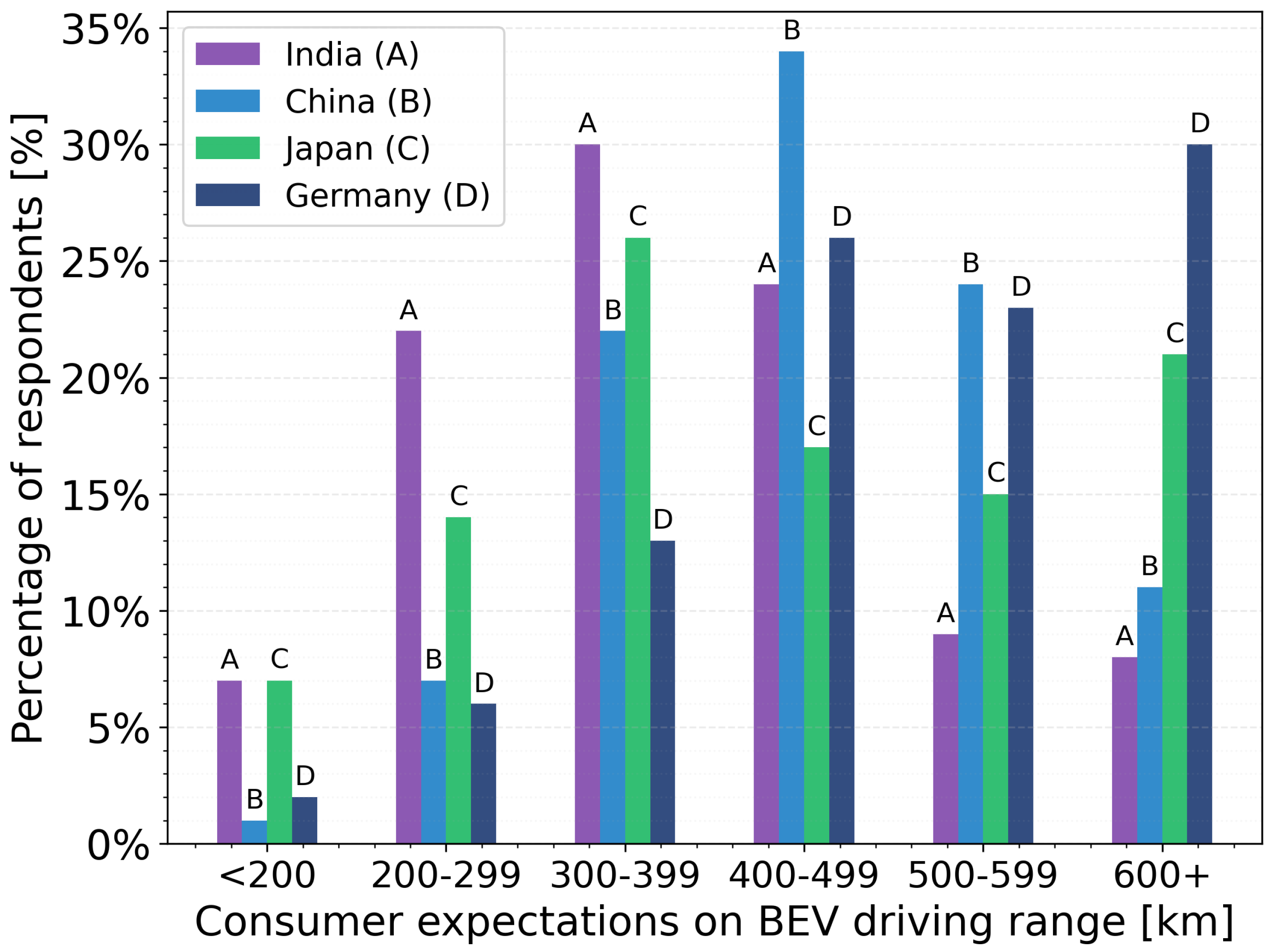
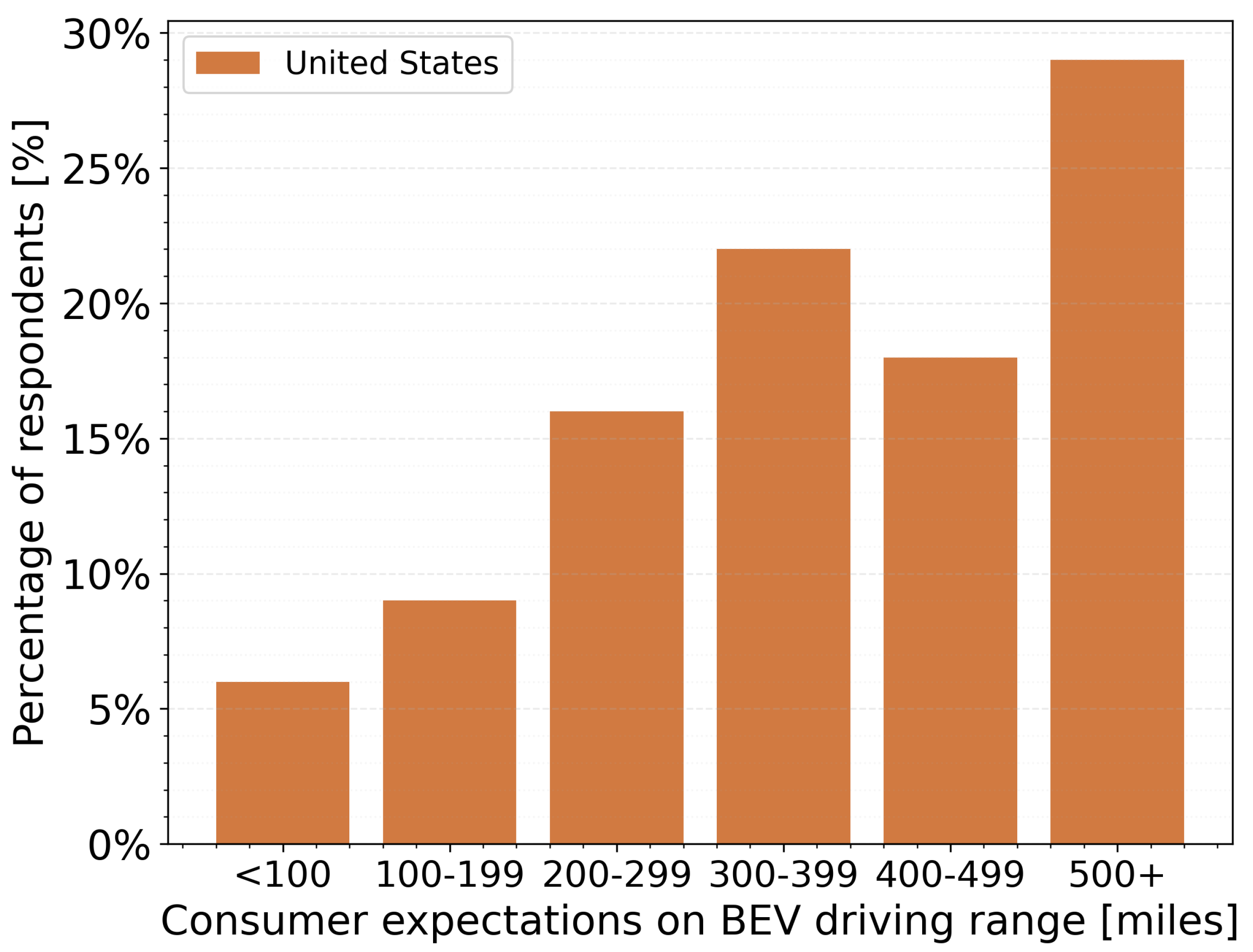


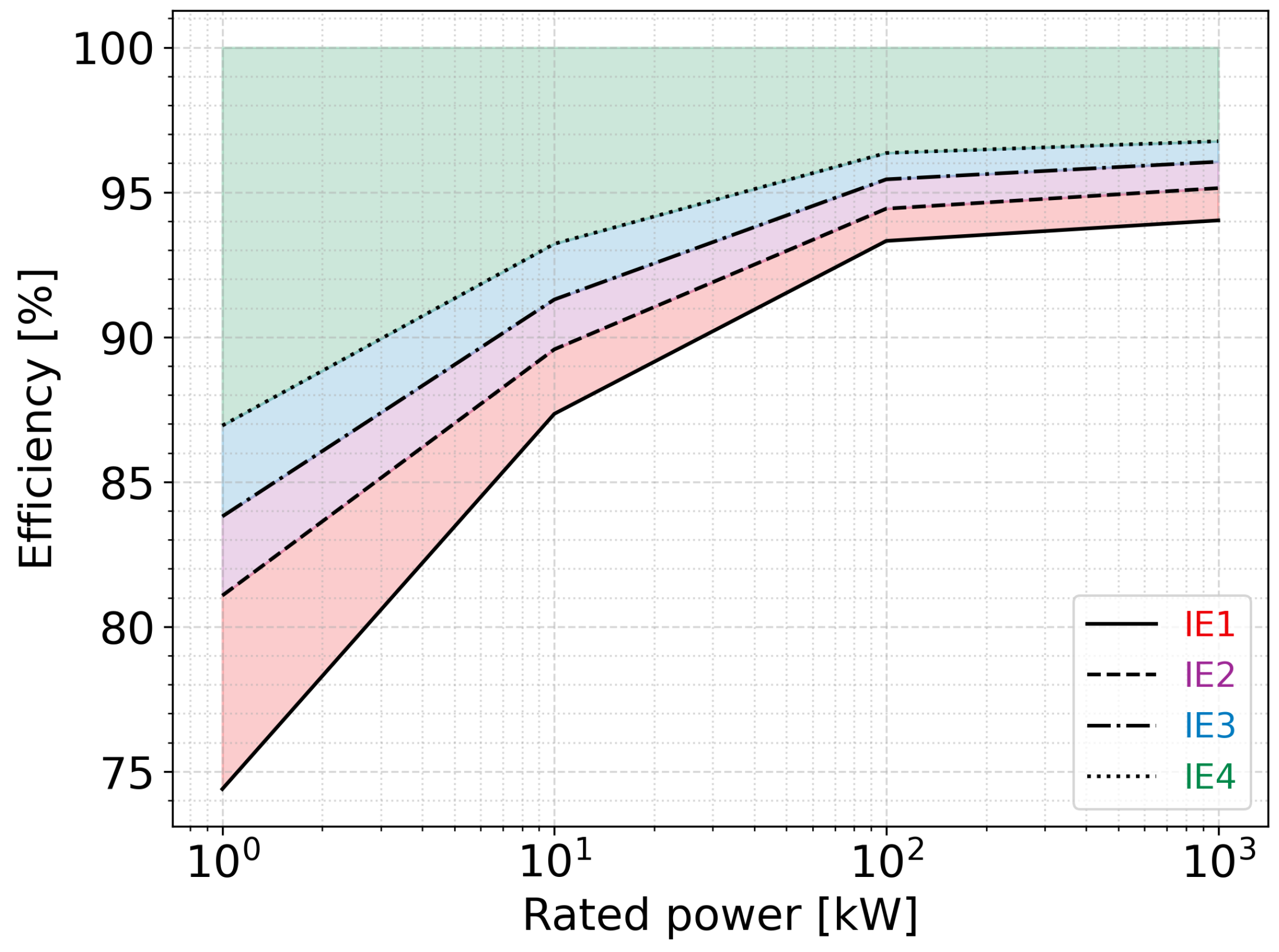

| Power | Torque | Acc. | NBC | UW (EU) | ||
|---|---|---|---|---|---|---|
| [kW] | [Nm] | [km/h] | [s] | [kWh] | [kg] | |
| Min. A | 33 | 113 | 125 | 11.6 | 17.6 | 1012 |
| Max. A | 66 | 210 | 135 | 19.1 | 36.8 | 1248 |
| Avg. A | 54 | 155 | 129 | 13.0 | 25.0 | 1121 |
| Min. B | 70 | 220 | 135 | 7.9 | 23.8 | 1281 |
| Max. B | 150 | 395 | 167 | 9.9 | 67.5 | 1757 |
| Avg. B | 102 | 287 | 149 | 9.0 | 39.0 | 1573 |
| A to B | 88% | 85% | 16% | −44% | 56% | 35% |
| New York | City | Xian | Beijing | Florence | |
|---|---|---|---|---|---|
| Time [s] | 600 | 1385 | 1200 | 2535 | 3000 |
| Dist. [km] | 1.90 | 11.99 | 7.33 | 14.42 | 20.36 |
| Idle time [%] | 40.93% | 20.42% | 17.60% | 24.40% | 15.51% |
| Stops [1/km] | 5.80 | 1.50 | 1.51 | 1.24 | 2.26 |
| [km/h] | 11.36 | 31.14 | 21.98 | 20.49 | 24.43 |
| [km/h] | 44.58 | 91.25 | 69.45 | 69.40 | 68.05 |
Disclaimer/Publisher’s Note: The statements, opinions and data contained in all publications are solely those of the individual author(s) and contributor(s) and not of MDPI and/or the editor(s). MDPI and/or the editor(s) disclaim responsibility for any injury to people or property resulting from any ideas, methods, instructions or products referred to in the content. |
© 2024 by the authors. Licensee MDPI, Basel, Switzerland. This article is an open access article distributed under the terms and conditions of the Creative Commons Attribution (CC BY) license (https://creativecommons.org/licenses/by/4.0/).
Share and Cite
Katona, M.; Orosz, T. Circular Economy Aspects of Permanent Magnet Synchronous Reluctance Machine Design for Electric Vehicle Applications: A Review. Energies 2024, 17, 1408. https://doi.org/10.3390/en17061408
Katona M, Orosz T. Circular Economy Aspects of Permanent Magnet Synchronous Reluctance Machine Design for Electric Vehicle Applications: A Review. Energies. 2024; 17(6):1408. https://doi.org/10.3390/en17061408
Chicago/Turabian StyleKatona, Mihály, and Tamás Orosz. 2024. "Circular Economy Aspects of Permanent Magnet Synchronous Reluctance Machine Design for Electric Vehicle Applications: A Review" Energies 17, no. 6: 1408. https://doi.org/10.3390/en17061408
APA StyleKatona, M., & Orosz, T. (2024). Circular Economy Aspects of Permanent Magnet Synchronous Reluctance Machine Design for Electric Vehicle Applications: A Review. Energies, 17(6), 1408. https://doi.org/10.3390/en17061408






